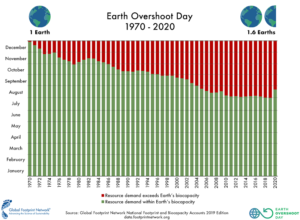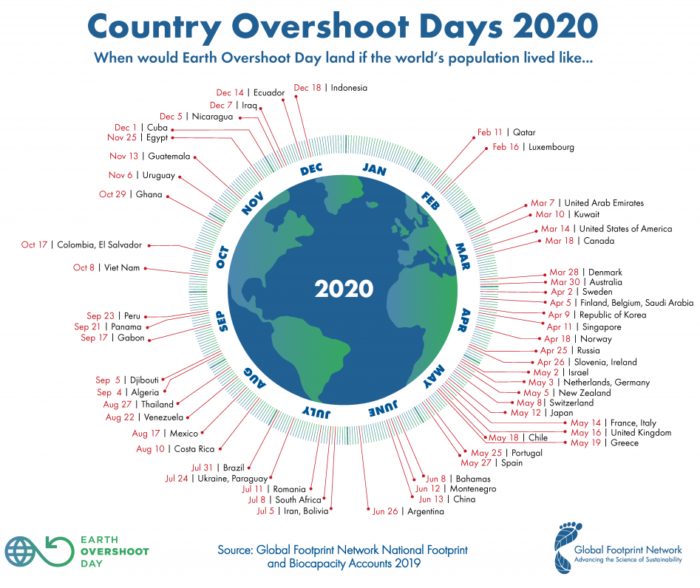22 Aug 2020 Today, August 22nd is Earth Overshoot Day 2020
“A relevant question we all need to ask ourselves as citizens, consumers, workers, savers, investors, in our daily life as well as when we are on holiday. Everything is tightly interconnected, the environmental disaster at the Mauritius and our personal habits at home”, states Daniela Carosio, SVI Senior Partner. “We all need to contribute strategically to reverse the trend and consolidate the nearly a month saved in resources in 2020 versus 2019. This is our commitment also through our ESG and impact investing analysis”
Today, 22 August 2020, we have reached the Earth Overshoot Day: “the date when humanity’s demand for ecological resources and services in a given year exceeds what Earth can regenerate in that year“.
The Earth Overshoot Day is calculated by the Global Footprint Network, an international non-profit and research organization founded in 2003 and focused on sustainability.
The date is estimated by dividing the Earth’s biocapacity, thus the amount of ecological assets the planet is able to generate and supply for that year (including forest lands, grazing lands, cropland, fishing grounds, and built-up land), by the humanity’s ecological footprint, which is the population’s demand for ecological resources (such as food, urban space, forests to absorb our emissions of carbon dioxide), and finally multiplying it by the number of days in a year (365).
Global biocapacity and ecological footprint are determined using more than fifteen thousand data points per country, largely provided by the United Nations. If the population demand for ecological resources surpasses the biocapacity available, we run an ecological deficit. At a country level, when a region runs an ecological deficit, it meets the exceeding demand through importing, liquidating its own ecological resources (such as overfishing) and/or increasing CO2 emissions. At the planetary level, the ecological deficit and overshoot coincide since there is no possibility for the planet to import resources.
Each year, the date is calculated using ecological footprint and biocapacity estimations “nowcasted” to the current year, using the most updated data available. For this reason, every year the organization recalculates both the metrics used to estimate the Earth Overshoot Day for the past years and the past dates accordingly.
This year’s Earth Overshoot Day has, for the first time in years, arrived later than it did the year before. This result has to be attributed to the global lockdowns set in response to the Covid-19 pandemic which reduced humanity’s ecological footprint by 9.3%, according to Global Footprint Network.
 Global Footprint Network provides also Country Overshoot Days. A country’s overshoot day marks the date when Earth Overshoot Day would have fell if the whole world consumed like the people of that country. According to Global Footprint Network, if the entire humanity consumed like the United States of America global biocapacity would have been exhausted by March 14th. If the entire world consumed like Italians or French people, Earth Overshoot Day would have been on May 14th, two months later.
Global Footprint Network provides also Country Overshoot Days. A country’s overshoot day marks the date when Earth Overshoot Day would have fell if the whole world consumed like the people of that country. According to Global Footprint Network, if the entire humanity consumed like the United States of America global biocapacity would have been exhausted by March 14th. If the entire world consumed like Italians or French people, Earth Overshoot Day would have been on May 14th, two months later.
Questions can be raised on the methodology used to determine the date of the Overshoot days as it does not differentiate between sustainable and unsustainable uses of resources, and does not take into consideration other means of carbon emissions absorption like ocean and soil. However, it remains a tangible and simple tool to show and increase awareness on the human impact on the ecosystem.
What can we do?
“A relevant question we all need to ask ourselves as citizens, consumers, workers, savers, investors, in our daily life as well as when we are on holiday. Everything is tightly interconnected, the environmental disaster at the Mauritius and our personal habits at home”, states Daniela Carosio, SVI Senior Partner. “We all need to contribute strategically to reverse the trend and consolidate the nearly a month saved in resources in 2020 versus 2019. This is our commitment also through our ESG and impact investing analysis”.
For further information see the following links:
